Sangpil Kim
AgriChrono: A Multi-modal Dataset Capturing Crop Growth and Lighting Variability with a Field Robot
Aug 26, 2025Abstract:Existing datasets for precision agriculture have primarily been collected in static or controlled environments such as indoor labs or greenhouses, often with limited sensor diversity and restricted temporal span. These conditions fail to reflect the dynamic nature of real farmland, including illumination changes, crop growth variation, and natural disturbances. As a result, models trained on such data often lack robustness and generalization when applied to real-world field scenarios. In this paper, we present AgriChrono, a novel robotic data collection platform and multi-modal dataset designed to capture the dynamic conditions of real-world agricultural environments. Our platform integrates multiple sensors and enables remote, time-synchronized acquisition of RGB, Depth, LiDAR, and IMU data, supporting efficient and repeatable long-term data collection across varying illumination and crop growth stages. We benchmark a range of state-of-the-art 3D reconstruction models on the AgriChrono dataset, highlighting the difficulty of reconstruction in real-world field environments and demonstrating its value as a research asset for advancing model generalization under dynamic conditions. The code and dataset are publicly available at: https://github.com/StructuresComp/agri-chrono
Reconstruction Using the Invisible: Intuition from NIR and Metadata for Enhanced 3D Gaussian Splatting
Aug 20, 2025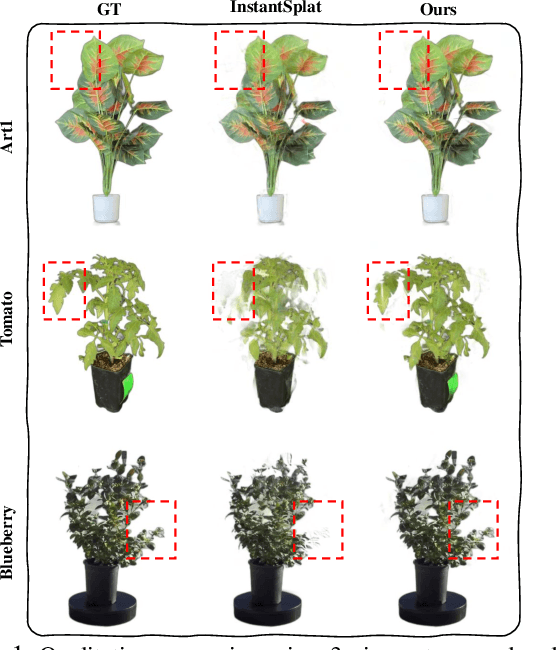
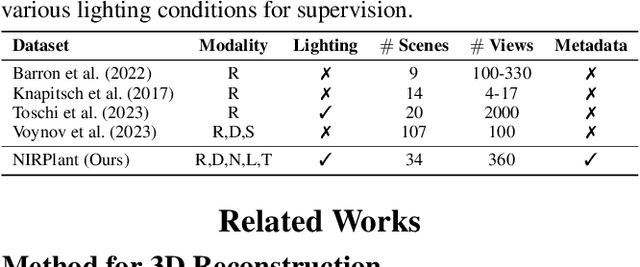
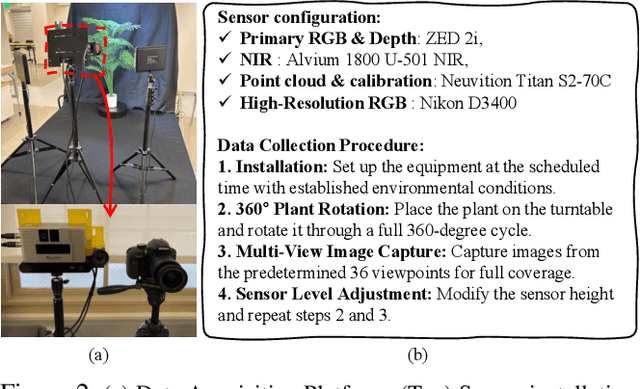
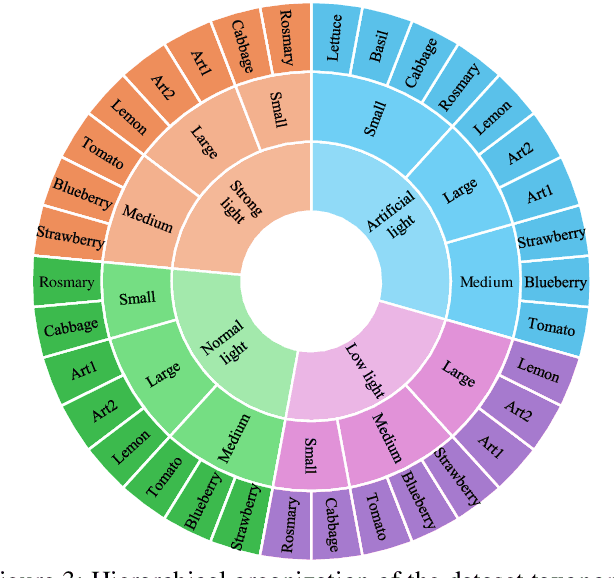
Abstract:While 3D Gaussian Splatting (3DGS) has rapidly advanced, its application in agriculture remains underexplored. Agricultural scenes present unique challenges for 3D reconstruction methods, particularly due to uneven illumination, occlusions, and a limited field of view. To address these limitations, we introduce \textbf{NIRPlant}, a novel multimodal dataset encompassing Near-Infrared (NIR) imagery, RGB imagery, textual metadata, Depth, and LiDAR data collected under varied indoor and outdoor lighting conditions. By integrating NIR data, our approach enhances robustness and provides crucial botanical insights that extend beyond the visible spectrum. Additionally, we leverage text-based metadata derived from vegetation indices, such as NDVI, NDWI, and the chlorophyll index, which significantly enriches the contextual understanding of complex agricultural environments. To fully exploit these modalities, we propose \textbf{NIRSplat}, an effective multimodal Gaussian splatting architecture employing a cross-attention mechanism combined with 3D point-based positional encoding, providing robust geometric priors. Comprehensive experiments demonstrate that \textbf{NIRSplat} outperforms existing landmark methods, including 3DGS, CoR-GS, and InstantSplat, highlighting its effectiveness in challenging agricultural scenarios. The code and dataset are publicly available at: https://github.com/StructuresComp/3D-Reconstruction-NIR
Text-Aware Image Restoration with Diffusion Models
Jun 11, 2025Abstract:Image restoration aims to recover degraded images. However, existing diffusion-based restoration methods, despite great success in natural image restoration, often struggle to faithfully reconstruct textual regions in degraded images. Those methods frequently generate plausible but incorrect text-like patterns, a phenomenon we refer to as text-image hallucination. In this paper, we introduce Text-Aware Image Restoration (TAIR), a novel restoration task that requires the simultaneous recovery of visual contents and textual fidelity. To tackle this task, we present SA-Text, a large-scale benchmark of 100K high-quality scene images densely annotated with diverse and complex text instances. Furthermore, we propose a multi-task diffusion framework, called TeReDiff, that integrates internal features from diffusion models into a text-spotting module, enabling both components to benefit from joint training. This allows for the extraction of rich text representations, which are utilized as prompts in subsequent denoising steps. Extensive experiments demonstrate that our approach consistently outperforms state-of-the-art restoration methods, achieving significant gains in text recognition accuracy. See our project page: https://cvlab-kaist.github.io/TAIR/
Active Test-time Vision-Language Navigation
Jun 07, 2025Abstract:Vision-Language Navigation (VLN) policies trained on offline datasets often exhibit degraded task performance when deployed in unfamiliar navigation environments at test time, where agents are typically evaluated without access to external interaction or feedback. Entropy minimization has emerged as a practical solution for reducing prediction uncertainty at test time; however, it can suffer from accumulated errors, as agents may become overconfident in incorrect actions without sufficient contextual grounding. To tackle these challenges, we introduce ATENA (Active TEst-time Navigation Agent), a test-time active learning framework that enables a practical human-robot interaction via episodic feedback on uncertain navigation outcomes. In particular, ATENA learns to increase certainty in successful episodes and decrease it in failed ones, improving uncertainty calibration. Here, we propose mixture entropy optimization, where entropy is obtained from a combination of the action and pseudo-expert distributions-a hypothetical action distribution assuming the agent's selected action to be optimal-controlling both prediction confidence and action preference. In addition, we propose a self-active learning strategy that enables an agent to evaluate its navigation outcomes based on confident predictions. As a result, the agent stays actively engaged throughout all iterations, leading to well-grounded and adaptive decision-making. Extensive evaluations on challenging VLN benchmarks-REVERIE, R2R, and R2R-CE-demonstrate that ATENA successfully overcomes distributional shifts at test time, outperforming the compared baseline methods across various settings.
3D Occupancy Prediction with Low-Resolution Queries via Prototype-aware View Transformation
Mar 19, 2025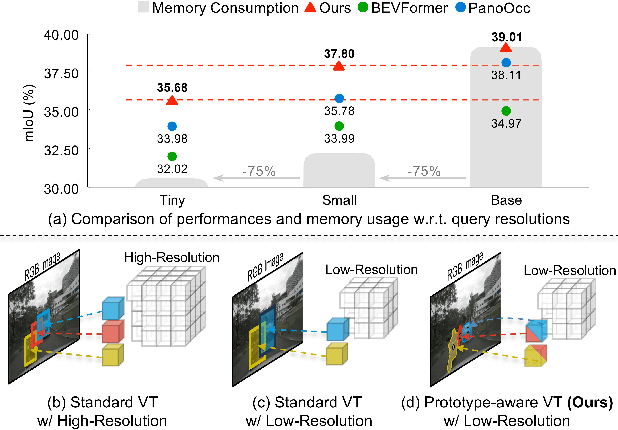
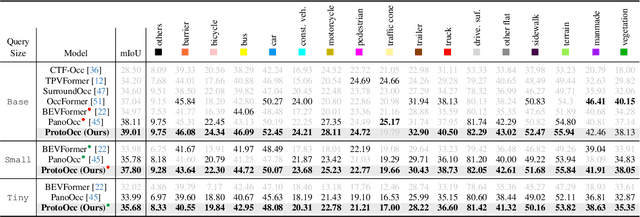
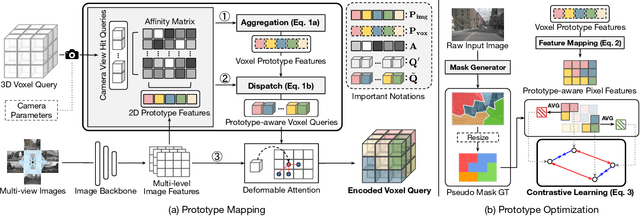
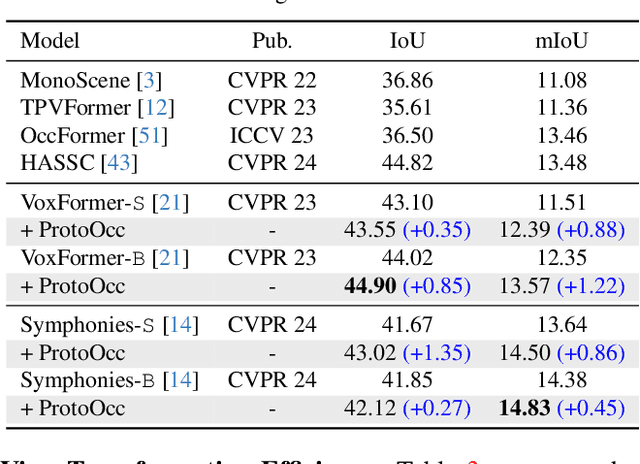
Abstract:The resolution of voxel queries significantly influences the quality of view transformation in camera-based 3D occupancy prediction. However, computational constraints and the practical necessity for real-time deployment require smaller query resolutions, which inevitably leads to an information loss. Therefore, it is essential to encode and preserve rich visual details within limited query sizes while ensuring a comprehensive representation of 3D occupancy. To this end, we introduce ProtoOcc, a novel occupancy network that leverages prototypes of clustered image segments in view transformation to enhance low-resolution context. In particular, the mapping of 2D prototypes onto 3D voxel queries encodes high-level visual geometries and complements the loss of spatial information from reduced query resolutions. Additionally, we design a multi-perspective decoding strategy to efficiently disentangle the densely compressed visual cues into a high-dimensional 3D occupancy scene. Experimental results on both Occ3D and SemanticKITTI benchmarks demonstrate the effectiveness of the proposed method, showing clear improvements over the baselines. More importantly, ProtoOcc achieves competitive performance against the baselines even with 75\% reduced voxel resolution.
PASTA: Part-Aware Sketch-to-3D Shape Generation with Text-Aligned Prior
Mar 17, 2025Abstract:A fundamental challenge in conditional 3D shape generation is to minimize the information loss and maximize the intention of user input. Existing approaches have predominantly focused on two types of isolated conditional signals, i.e., user sketches and text descriptions, each of which does not offer flexible control of the generated shape. In this paper, we introduce PASTA, the flexible approach that seamlessly integrates a user sketch and a text description for 3D shape generation. The key idea is to use text embeddings from a vision-language model to enrich the semantic representation of sketches. Specifically, these text-derived priors specify the part components of the object, compensating for missing visual cues from ambiguous sketches. In addition, we introduce ISG-Net which employs two types of graph convolutional networks: IndivGCN, which processes fine-grained details, and PartGCN, which aggregates these details into parts and refines the structure of objects. Extensive experiments demonstrate that PASTA outperforms existing methods in part-level editing and achieves state-of-the-art results in sketch-to-3D shape generation.
CompMarkGS: Robust Watermarking for Compression 3D Gaussian Splatting
Mar 17, 2025Abstract:3D Gaussian Splatting (3DGS) enables rapid differentiable rendering for 3D reconstruction and novel view synthesis, leading to its widespread commercial use. Consequently, copyright protection via watermarking has become critical. However, because 3DGS relies on millions of Gaussians, which require gigabytes of storage, efficient transfer and storage require compression. Existing 3DGS watermarking methods are vulnerable to quantization-based compression, often resulting in the loss of the embedded watermark. To address this challenge, we propose a novel watermarking method that ensures watermark robustness after model compression while maintaining high rendering quality. In detail, we incorporate a quantization distortion layer that simulates compression during training, preserving the watermark under quantization-based compression. Also, we propose a learnable watermark embedding feature that embeds the watermark into the anchor feature, ensuring structural consistency and seamless integration into the 3D scene. Furthermore, we present a frequency-aware anchor growing mechanism to enhance image quality in high-frequency regions by effectively identifying Guassians within these regions. Experimental results confirm that our method preserves the watermark and maintains superior image quality under high compression, validating it as a promising approach for a secure 3DGS model.
AV-Surf: Surface-Enhanced Geometry-Aware Novel-View Acoustic Synthesis
Mar 17, 2025Abstract:Accurately modeling sound propagation with complex real-world environments is essential for Novel View Acoustic Synthesis (NVAS). While previous studies have leveraged visual perception to estimate spatial acoustics, the combined use of surface normal and structural details from 3D representations in acoustic modeling has been underexplored. Given their direct impact on sound wave reflections and propagation, surface normals should be jointly modeled with structural details to achieve accurate spatial acoustics. In this paper, we propose a surface-enhanced geometry-aware approach for NVAS to improve spatial acoustic modeling. To achieve this, we exploit geometric priors, such as image, depth map, surface normals, and point clouds obtained using a 3D Gaussian Splatting (3DGS) based framework. We introduce a dual cross-attention-based transformer integrating geometrical constraints into frequency query to understand the surroundings of the emitter. Additionally, we design a ConvNeXt-based spectral features processing network called Spectral Refinement Network (SRN) to synthesize realistic binaural audio. Experimental results on the RWAVS and SoundSpace datasets highlight the necessity of our approach, as it surpasses existing methods in novel view acoustic synthesis.
CATSplat: Context-Aware Transformer with Spatial Guidance for Generalizable 3D Gaussian Splatting from A Single-View Image
Dec 17, 2024



Abstract:Recently, generalizable feed-forward methods based on 3D Gaussian Splatting have gained significant attention for their potential to reconstruct 3D scenes using finite resources. These approaches create a 3D radiance field, parameterized by per-pixel 3D Gaussian primitives, from just a few images in a single forward pass. However, unlike multi-view methods that benefit from cross-view correspondences, 3D scene reconstruction with a single-view image remains an underexplored area. In this work, we introduce CATSplat, a novel generalizable transformer-based framework designed to break through the inherent constraints in monocular settings. First, we propose leveraging textual guidance from a visual-language model to complement insufficient information from a single image. By incorporating scene-specific contextual details from text embeddings through cross-attention, we pave the way for context-aware 3D scene reconstruction beyond relying solely on visual cues. Moreover, we advocate utilizing spatial guidance from 3D point features toward comprehensive geometric understanding under single-view settings. With 3D priors, image features can capture rich structural insights for predicting 3D Gaussians without multi-view techniques. Extensive experiments on large-scale datasets demonstrate the state-of-the-art performance of CATSplat in single-view 3D scene reconstruction with high-quality novel view synthesis.
EditSplat: Multi-View Fusion and Attention-Guided Optimization for View-Consistent 3D Scene Editing with 3D Gaussian Splatting
Dec 16, 2024



Abstract:Recent advancements in 3D editing have highlighted the potential of text-driven methods in real-time, user-friendly AR/VR applications. However, current methods rely on 2D diffusion models without adequately considering multi-view information, resulting in multi-view inconsistency. While 3D Gaussian Splatting (3DGS) significantly improves rendering quality and speed, its 3D editing process encounters difficulties with inefficient optimization, as pre-trained Gaussians retain excessive source information, hindering optimization. To address these limitations, we propose \textbf{EditSplat}, a novel 3D editing framework that integrates Multi-view Fusion Guidance (MFG) and Attention-Guided Trimming (AGT). Our MFG ensures multi-view consistency by incorporating essential multi-view information into the diffusion process, leveraging classifier-free guidance from the text-to-image diffusion model and the geometric properties of 3DGS. Additionally, our AGT leverages the explicit representation of 3DGS to selectively prune and optimize 3D Gaussians, enhancing optimization efficiency and enabling precise, semantically rich local edits. Through extensive qualitative and quantitative evaluations, EditSplat achieves superior multi-view consistency and editing quality over existing methods, significantly enhancing overall efficiency.
 Add to Chrome
Add to Chrome Add to Firefox
Add to Firefox Add to Edge
Add to Edge